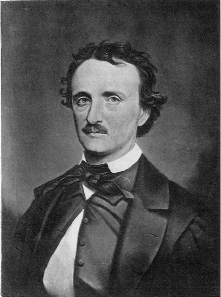Biography

Edgar Allan Poe
Painting by Oscar Halling
Edgar Poe was born in Boston on January 19, 1809, to Elizabeth and David Poe. After the mother’s death, different families cared for the Poe children. Edgar was taken in by Frances and John Allan of Richmond, Virginia, and was renamed Edgar Allan. The tobacco merchant never legally adopted the boy.
Edgar attended school in Richmond and, in years 1815-20, in Scotland and England. Afterwards, Edgar resumed studies in Richmond, and entered University of Virginia in 1826, excelling in ancient and modern languages.
Although now wealthy, Allan refused to provide Poe with full funds for the university. To meet expenses, Poe gambled, adding to his difficulties. Unable to continue at Virginia, he enlisted, in 1827, in the U.S. Army, and was posted at Fort Independence, Boston Harbor. During this time his first book, Tamerlane and Other Poems, appeared, without winning attention. A second, in 1829, won a favorable review. By the time Poe published his third, in 1830, he had withdrawn from the military, and John Allan, already unsupportive, had severed relations.
Poe began residing in Baltimore with paternal aunt Maria Clemm and her daughter Virginia, whom he would marry. After having stories published by the Philadelphia Saturday Courier, Poe found significant affirmation of his talent when, in October, 1833, his story “MS. Found in a Bottle” won the $50 first prize from the Baltimore Saturday Visiter.
Poe soon began his association with The Southern Literary Messenger, in which “Hans Phaall” appeared. He served as editor and chief book-reviewer, resigning in 1837 over salary. After moving to New York, The Narrative of Arthur Gordon Pym was published by Harper’s. In 1839, Tales of the Grotesque and Arabesque was published in two volumes.
In 1841 Poe became an editor of Graham’s Magazine, which published “The Murders in the Rue Morgue,” his first “tale of ratiocination.” Poe oversaw the magazine’s rapid rise in readership, before his resignation in 1842. In that year Virginia burst a blood vessel, from which she would never fully recover; and Poe met Charles Dickens. The following years saw alternations between artistic success and personal decline. In 1843, “The Gold-Bug” won for Poe a $100 prize from the Philadelphia Dollar Newspaper. His 1844 hoax in the New York Sun about the first balloon-crossing of the Atlantic added to his fame.
He joined the New York Evening Mirror staff, and in its pages, in 1845, published “The Raven,” to great acclaim. He assumed editorship of the Broadway Journal that year, then ownership. Illness and hardship forced him to cease publication by 1846. The Poe household suffered greatly that year and the next, when Virginia died. Despite suffering from grave illness himself, Poe began work on cosmological theories, resulting in 1848’s Eureka.
Financial and resulting mental instability plagued Poe to the last. He was found delirious outside a polling booth in Baltimore, on October 3, 1849, possibly a victim of political hazing. He died October 7. His reputation nearly died as well, blackened by Rufus Griswold’s slanderous obituary.
Mark Rich
September 2009